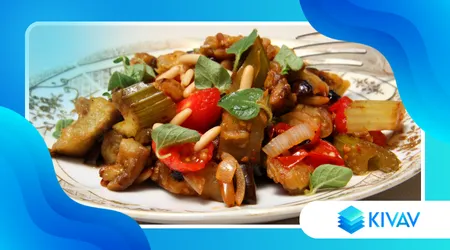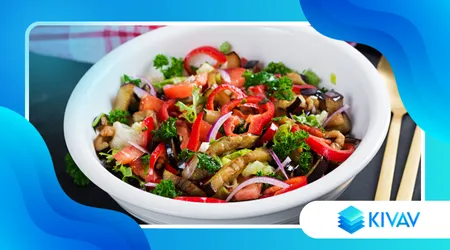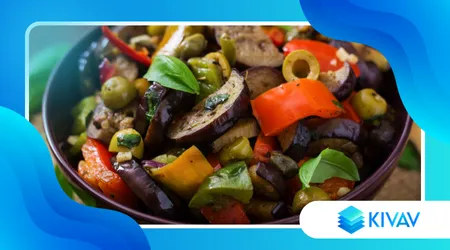Palermo-style white caponata: a delicate variation on the classic recipe.

There Palermo-style white caponata represents a refined deviation from the beaten path of the traditional recipe, notoriously dark and intense.
Announcements
This isn't just a simple aesthetic change. This Palermo specialty takes a more ethereal approach.
It focuses on ingredients that maintain a light color and a more delicate flavor. Eggplants, often peeled or of pale varieties, avoid prolonged frying in dark oil.
Tomato sauce is completely omitted in this recipe. This is its most obvious and significant distinguishing feature.
The absence of red sauce determines the "whiteness" of the final dish. The result is a side or appetizers more graceful.
Announcements
The sweet and sour taste, a crucial element, is maintained. The balance between white wine vinegar and sugar remains essential.
However, the overall aromatic profile is more sober, almost whispered. There's no overbearing tomato flavor dominating the scene.
The freshness of the ingredients stands out the most. It's a different and equally rewarding sensory experience. In practice, it's a side which invites meditation on flavor.
What are the key ingredients and unique preparation techniques?
The composition of the Palermo-style white caponata It relies on a few select protagonists. Light-colored or peeled eggplants are the heart of the dish.
Crispy celery and white onion follow. Desalted Salina capers add flavor. The acidity comes from the white wine vinegar.
Sugar balances the tartness with its sweetness. Pine nuts and almonds are sometimes added. Raisins, if used, are used in moderate quantities.
The technique is meticulous and respectful of the ingredients. Preparation requires care to maintain the clarity of the dish.
Eggplants are often fried briefly and at a low temperature. Alternatively, they are blanched or steamed to maintain their color.
The secret lies in the final "conza." It's the blend of ingredients with the warm sweet and sour sauce.
This stage is crucial for the balance of flavors. It's not just a dish, but a process of chemical-gustatory balance.

Why has Caponata Bianca gained popularity in contemporary cuisine?
There Palermo-style white caponata It's enjoying a well-deserved renaissance. Contemporary cuisine appreciates its lightness.
This appetizers It responds to the need for less intense flavors. Today's consumers seek refinement and digestibility.
Learn more: Green bean salad with parmesan shavings and lemon
This caponata It elegantly offers both qualities. It's perceived as a healthier choice than the dark, fried version.
Its neutral color also makes it versatile. It pairs easily with fish dishes.
From an aesthetic point of view, it is perfect for the food styling Modern. Its clean, bright look attracts attention.
It's a photogenic and Instagrammable dish. Top chefs often reimagine it with innovative twists. One example is the addition of candied ginger.
Or the use of more refined vinegars like apple cider vinegar. Its popularity is in line with the "less is more" trend.
How do history and tradition support the authenticity of this variant? Palermo-style white caponata
This variation isn't a recent invention. Its roots are deeply rooted in Palermo's gastronomic history.
Historical Sicilian cuisine is full of regional adaptations and variations. Caponata is a humble, leftover dish.
Variations arose from the local availability of ingredients. In some areas, the widespread use of tomatoes was less common. This paved the way for lighter versions.
Historian Gaetano Basile has often emphasized the dynamic evolution of Sicilian cuisine. Caponata it is a “mosaic plate” of influences.
Interesting: Crostini with black truffle
The evolution of this appetizers It's natural. There are no monolithic, fixed recipes. Tradition thrives on local and seasonal interpretations.
This flexibility ensures the authenticity of variants such as the Palermo-style white caponataIt bears witness to the cultural richness of Palermo.
| Caponata Variations Compared | Dominant Color | Presence of Tomato Sauce | Prevalent Taste Profile | Recommended Pairings |
| Classical (Catanese/Neapolitan) | Dark/Red | Yes | Intense, Rustic, Deep Bittersweet | Red Meat, Homemade Bread |
| Palermo-style white caponata | Light/Pale Yellow | No | Delicate, Fresh, Sophisticated Sweet and Sour | White Fish, Shellfish, Fresh Cheeses |
This table highlights the main differences. It shows how the white version isn't inferior. It's simply different.
What are the benefits and tips for successful plating? Palermo-style white caponata
Besides the taste, this Caponata It offers several benefits. Its light composition makes it lower in calories.
The use of low-glycemic index vegetables is a plus, making it suitable for a variety of dietary needs. It's an excellent source of fiber and antioxidants.
As an analogy, the Palermo-style white caponata it's like a delicate watercolor.
The classic caponata, on the other hand, is a dense, saturated oil painting. Both are art, but with different techniques and impacts.
Proper plating is crucial to enhancing this recipe. The goal is to highlight its light color. You can use a pastry cutter to create a cylindrical shape.
Garnish with a fresh basil leaf. A drizzle of new extra virgin olive oil will finish the look. Serving it in individual bowls is a classy touch.

How does Caponata Bianca fit into the 2025 food trends?
It's 2025 and the trends food They're clear. There's a strong push toward plant-based and sustainable regional cuisine.
A 2024 analysis of the Future Market Insights (FMI) on the “Plant-Based Appetizers” market in Italy has revealed an increase in interest of 18% for the side dishes traditional revisited in a light key.
There Palermo-style white caponata It fits perfectly here. She's vegetarian, gluten-free and pay attention to lightness.
A Michelin-starred restaurant in Milan served it with tuna bottarga, creating a contrast between land and sea.
A food blogger A Roman used it as a filling for a ravioli. It demonstrated its unexpected versatility.
This caponata It's not just a dish. It's a culinary declaration of intent. A Sicilian manifesto looking to the future.
But deep down, shouldn't we always seek a balance between tradition and innovation in what we eat?
there Palermo-style white caponata It's more than just a variation. It's a masterpiece of balance and finesse.
It offers an unexpected taste experience. It honors Sicilian tradition with respect and creativity. It's a appetizers which deserves its place of honor.
Frequently Asked Questions
Can I use common purple eggplants?
Yes, but it's recommended to peel them completely. This helps maintain the desired light color for the final dish.
What's the secret to a perfect sweet and sour sauce?
The secret lies in personal balance. You have to taste and adjust gradually. The ratio between vinegar and sugar must create a tête-à-tête pleasant.
How long does white caponata keep?
Store in the refrigerator in an airtight container. It can be kept for up to 4-5 days. The flavor intensifies after the first day.
Can you freeze white caponata?
Technically possible, but not recommended. The freezing and thawing process could alter the crispiness of the vegetables.
Is it served hot or cold?
Traditionally, it's best served at room temperature. Or, even better, slightly chilled from the refrigerator to enhance the sweet and sour flavor.
